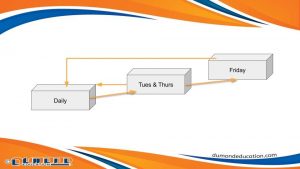CardEd, Study Skills
CardEd and the Leitner System: A Perfect Match!
Learning-to-Learn
At Dumond, we believe it is important to introduce children to strategies and skills which support learning from a young age. These are sometimes termed ‘learning-to-learn strategies’ (Cornford, 2002) .
In introducing these strategies, the goal is not for the child to use them independently – young learners do not have the necessary maturity to monitor their own learning (meta-cognitive awareness) and apply them – rather, the benefit is in forming good habits and teaching skills that will be highly useful later on.
Flashcards, Spaced Practice & The Leitner System
One such method is the Leitner System, named after the German scientist who designed it. The Leitner System involves the use of flashcards and spaced practice.
The spacing effect (discovered by another German, Hermann Ebbinghaus) shows us how learning is most effective if the information is spaced out over time. This is achieved by spaced practice – dividing the learning up into short sessions over a longer period of time – which forces the brain to work harder to retrieve information and so promotes storage strength (See the work of Robert Bjork on memory).
Flashcards are excellent learning tools as they promote active learning. To use the Leitner System to full effect, each flashcard should have one piece of information on it, e.g.,
- A word on the front and the definition on the back;
- A question on the front and the answer on the back;
- The name of a mathematical formula on the front and the complete formula on the back;
- An acronym on the front and its meaning on the back;
- A date on the front and a significant historical event on the back.
- A country on the front and its capital on the back.
In order to embed the learning (and to support later retrieval), flashcards should be studied both ways. In example 1 above, you would check whether you can define the word on the card. Next, check when given the definition, you can provide the word.
In the video accompanying today’s post, we use a modified version of the Leitner System with cards from CardEd Set 1 to review letter sounds. In this case, we are not using dual-sided cards and the child is not expected to work alone. Instead, we are focusing solely on the CardEd Set 1 Letter Zone. The idea is to introduce the child to a spaced practice method of working with adult support. This activity is quick and easy, requires minimal set-up, and is highly-effective, so teachers not already familiar with it may wish to add it to their repertoire, especially to reinforce material a particular learner may be struggling with.
In later videos, we will demonstrate how to use 2-sided cards to show children how to self-check their answers. It is important to be mindful of how young children love to please and may tell you all their answers were correct if left to work independently! Early independence is not the key idea in introducing them to this system at a young age; rather, we hope to set up good future study habits.
Introducing the Leitner System using CardEd Set 1
You will need:
- Flashcards of the material to be studied
- Three boxes or folders (labelled Daily / Tues & Thurs / Friday)
- CardEd Set 1
Method:
- Quiz the child on each card on Monday.
- If the content is known, place the card in Tues/Thurs box.
- If the content is unknown, it remains in the daily box.
- On Tuesday, review the daily box first and move known cards to Tues/Thurs box.
- Next, review the Tues/Thurs pile, moving any unknown cards to daily box.
- On Wednesday, review cards in the daily box, moving known ones to the Tues/Thurs pile.
- On Thursday, begin with cards in the daily box, moving known ones one place to the right to the Tues/Thurs box.
- Known cards in the Tues/Thurs box are moved to the Friday one; unknown cards are moved back to the daily box.
- On Friday, begin with the daily box as usual, keeping unknown cards there for ongoing review and moving known ones to the Tues/Thurs box.
- Review the cards in the Friday box.
- If any are unknown they must be returned to the daily pile.
- Check known ones can be recalled from both sides (start again by putting these known cards in the daily pile, following the same process to ensure they are known in reverse).
- Essentially, if an error is made, return the card to the daily box.
- Correct cards are moved one box to the right.

The Leitner System Diagram
Watch the video here:
See:
Cornford, I.R. (2002) Learning-to-learn strategies as a basis for effective lifelong learning. International Journal of Lifelong Education 21(4): pp.357-368.
